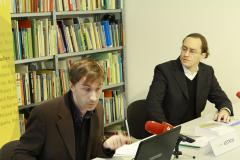No take-off so far, wait for external push

Vasily Astrov, Mario Holzner (photo © wiiw)
The outlook for the Central, East and Southeast European (CESEE) countries– most of which are small and open economies – is crucially dependent on the acceleration of recovery in the euro area and particularly in Germany. Otherwise, the cross-country differences in economic performance will be to a large extent due to the differences in the fiscal policies pursued.
Budget austerity is likely to dampen economic growth in Albania and Russia and may trigger outright recession in Serbia, while a welcome fiscal relaxation should be to varying degrees growth-conducive in the Czech Republic, Bulgaria, Romania and Kosovo.
All in all, wiiw projects that economic growth in the new EU Member States (NMS) will pick up to 2% on average next year and to around 3% in 2015.
Economic dynamics should also accelerate in several Western Balkan countries – though not in Serbia – and remain strong in Latvia, Lithuania and Kazakhstan, but will stay generally unimpressive in Russia and Ukraine.
Press Releases
Related Presentations
- No take-off so far, wait for external push
- Konjunkturelle Startschwierigkeiten – Warten auf externen Schub
